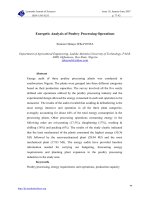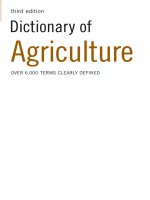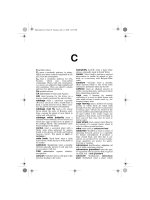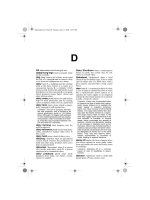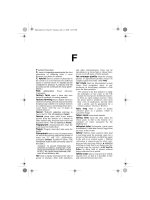Dictionary Of Invertebrate Zoology - U potx
Bạn đang xem bản rút gọn của tài liệu. Xem và tải ngay bản đầy đủ của tài liệu tại đây (72.83 KB, 10 trang )
U
uliginose, uliginous a. [L. uliginosus, swampy] Of or pertain-
ing to mud; swampy.
ultradextral a. [L. ultra, beyond; dexter, right] (
MOLL: Gastro-
poda) Having a shell appearing to be sinistral but soft parts
organized dextrally; hyperstrophic.
ultrasinistral a. [L. ultra, beyond; sinister, left] (
MOLL: Gas-
tropoda) Having a shell appearing to be dextral but soft
parts organized sinistrally; hyperstrophic.
ultrasonic a. [L. ultra, beyond; sonus, sound] High frequency
sounds inaudible to the human ear.
ultrastructure n. [L. ultra, beyond; struere, to construct] The
fine structure of cells seen with an ultramicroscope or an
electron microscope.
umbel n. [L. umbella, a sunshade] 1. An arrangement in which
a number of processes, nearly equal in length, spread from
a common center. 2. (
CNID: Anthozoa) In Umbellulidae,
polyps coming from a common center, forming a cluster, as
in the anthocodia of Umbellula . 3. (
PORIF) Processes ex-
tending from the clavules.
umbilical suture (
MOLL: Gastropoda) In phaneromphalous
type shells, a continuous line separating successive whorls.
umbilicus n.; pl. -lici [L. umbilicus, navel] 1. A navel, or na-
vel-like depression 2. (
MOLL: Gastropoda) A cavity formed
around the shell axis between the faces of the adaxial wall
of the whorls where these do not coalesce to form a solid
columella. a. In conispiral shells opening at the base of the
shell, excepting hyperstrophic type. b. Involute shells may
have two umbilici, an upper or adapical and lower or abapi-
cal in asymmetrical types, and left and right in isostrophic
types. umbilicate a.
umbo n.; pl. umbones, umbos [L. umbo, knob or boss] 1.
(
ARTHRO: Crustacea) a. In Cirripedia, a portion of the plate
from which successive growth increments extend. b. In bi-
Maggenti and Gardner 928
valves, apical portion of either valve. see beak. 2. (AR-
THRO:
Insecta) In Coleoptera, an elevated knob on the hu-
meral angle of the elytra. 3. (
BRACHIO) Apical portion of
either valve containing the beak. 4. (
BRYO: Gymnolaemata)
In Cheilostomates, a blunt knob on the front wall of the
ovicell. 5. (
MOLL: Bivalvia) That region of the valve sur-
rounding the point of maximum curvature of the longitudi-
nal dorsal profile; when not coinciding with the beak, ex-
tending to its base. umbonal a.
umbonal angle (
MOLL: Bivalvia) In pectinoid shells, the angle
of divergence of the umbonal folds; in other shells the di-
vergence of the posterodorsal and anterodorsal parts of the
longitudinal profile.
umbonal cavity (
MOLL: Bivalvia) 1. Part of the valve interior
which lies within the umbo and under the hinge plate. 2. In
oysters, that part of the left valve interior lying in the um-
bonal region beneath the ligamental area.
umbonal depression (
MOLL: Bivalvia) A depression at the
umbo tip.
umbonal fold (
MOLL: Bivalvia) In pectinoid shells, a ridge
originating at the umbo and setting the auricle off from the
shell body.
umbonal pole (
MOLL: Bivalvia) The point of maximum curva-
ture of the longitudinal profile of the dorsal valve.
umbonal reflection (
MOLL: Bivalvia) The reflection of the dor-
sal margin of the valves anterior to and usually over the
umbos.
umbonal region (
MOLL: Bivalvia) The region of the umbo.
umbonal spine (
ARTHRO: Crustacea) In Conchostraca, a hol-
low, curved, looped or nodular spinose projection of vari-
able size, sometimes covering the entire umbo.
umbone see umbo
umboniform a. [L. umbo, knob or boss; forma, shape] 1. Like
or shaped like an umbo. 2. (
MOLL: Gastropoda) Having a
low blunt or rounded spire, nearly lenticular in shape. see
rotelliform.
umbonuloid a. [L. umbo, knob or boss; Gr. eidos, like] (
BRYO:
Online Dictionary of Invertebrate Zoology 929
Gymnolaemata) In cheilostomates, autozooids having
frontal shields formed by calcification of the basal side of
the epifrontal fold.
umbo-veliger (
MOLLL:Bivalvia) In oysters, the last larval
stage.
umbraculate, umbraculiferous a. [L. umbraculum, sun-
shade] Bearing an umbrella-like structure or organ.
umbrella n. [L. dim. umbra, shade] 1. Any umbrella-shaped
structure. 2. The ectodermal cells located anterior to the
preoral band of cilia in the development of a trochophore
larva. 3. (
CNID: Scyphozoa) The deep to shallow bowl like
body of a medusa or jellyfish; the bell. see exumbrella,
subumbrella. 4. (
MOLL: Cephalopoda) The velum or inter-
brachial web interconnecting the head and arms of the fin-
ned octopods.
umbrella organ see sensillum campaniformium
unarmed a. [A.S. un-, not; L. arma, arms] Without armature
of any kind, i.e., shield, spurs, spines, plates, teeth, etc.
unarticulate a. [A.S. un-, not; L. articulare, to divide] Not
jointed or segmented.
uncate a. [L. uncus, hook] Hooked; hamate.
unci pl. uncus
unciform a. [L. uncus, hook; forma, shape] Hook-shaped.
uncinal plate see radula
uncinal seta (
ANN: Polychaeta) Setae modified into hooks,
functioning in feeding or gripping.
uncinate a. [L. uncinus, hook] 1. Hooked or barbed at the end;
unciniform. 2. (
PORIF) Pertaining to megascleres, a fusiform
oxea with thornlike spines.
uncinate mastax (
ROTIF) A mastax with fulcrum and manubria
greatly reduced, stout rami, and large subunci; specialized
for food laceration.
uncini n.pl; sing. uncinus [L. uncinus, hook] 1. (
ANN: Poly-
chaeta) Deeply embedded seta with only its multidentate
head showing above the cuticle. 2. (
MOLL: Gastropoda)
Numerous small teeth- or hook-like structures on the
Maggenti and Gardner 930
radula of plant-eating gastropods.
uncus n.; pl. unci [L. uncus hook] 1. (
ARTHRO: Insecta) a. In
some larvae, a hooked process on the distal inner margin
of the maxillary mala, possibly a reminant of the lacinia. b.
In Lepidoptera, a process of the 10th abdominal tergum
overhanging the anus. 2. (
ROTIF) One of a pair of the seven
main pieces of the mastax.
undate a. [L. unda, wave] Wavy, undulating.
underbridge n. [A.S. under, below; bricg, bridge] (
NEMATA:
Secernentea) In Heterodera cysts, a structure extending
across the vulval cone below and parallel to the vulval
bridge.
undifferentiated a. [A.S. un-, not; L. differens, dissimiler] 1.
Immature or embryonic form; unspecialized; capable of
differentiation into more specialized form. 2. With cells,
meaning an embryonic cell that can develop into other
types of cells.
undose a. [L. unda, wave] Undulating; nearly parallel depres-
sions blending more or less into each other.
undulate a. [L. unda, wave] Having a wavy surface or margin.
ungual a. [L. unguis, claw] Pertaining to the ungues or claws.
unguiculus n.; pl. unguiculi [L. dim. unguis, claw] 1. A small
terminal claw or nail-like process. 2. (
ARTHRO: Insecta) The
smaller of the toothed tarsal claws of Collembola. ungui-
culate a. see unguis.
unguifer n. [L. unguis, claw; ferre, to bear] (
ARTHRO: Insecta)
A median process of the last tarsomere, articulating with
the pretarsal claws.
unguiferate a. [L. unguis, claw; ferre, to bear] (
PORIF) Per-
taining to a type of chelate microsclere with short and dis-
crete teeth, often more than three at each end of the shaft.
unguiflexor n. [L. unguis, claw; flectere, to bend] (
ARTHRO:
Insecta) Muscles responsible for moving or extending the
ungues.
unguiform a. [L. unguis, claw; forma, shape] Shaped like a
claw.
unguis n.; pl. ungues [L. unguis, claw] (
ARTHRO) 1. The lat-
Online Dictionary of Invertebrate Zoology 931
eral claw of the pretarsus of several groups. 2. The larger
of the toothed tarsal claws of Collembola. ungual a. see
uguiculus, homodactyl.
unguitractor n. [L. unguis, claw; tract, to pull] (
ARTHRO: In-
secta) A ventral sclerotized plate of the pretarsus from
which arises the retractor muscles of the ungues or claws;
also called unguitractor plate.
unguitractor tendon (
ARTHRO: Insecta) The tendon serving
for attachment of the unguitractor to the pretarsal depres-
sor muscle; apodeme.
ungula see unguis
uniauriculate a. [L. unus, one; auricula, outer ear] Having a
single ear-like process.
unibranchiate a. [L. unus, one; branchia, gill] Having one gill.
unicameral a. [L. unus, one; camera, chamber] Having one
chamber.
unicapsular a. [L. unus, one; capsula, little box] Having only a
single capsule.
unicarinate a. [L. unus, one; carina, keel] Having a single
ridge or keel.
unicellular a. [L. unus, one; cellula, small chamber] Consisting
of only one cell.
uniciliate a. [L. unus, one; cilium, eyelash] Having a single
cilium or flagellum.
unicolonial a. [L. unus, one; colere, to dwell] (
ARTHRO: In-
secta) A population of social insects not recognizing nest
boundaries; multicolonial.
unicolorate a. [L. unus, one; color, tint] Having one color
throughout.
unicornous a. [L. unus, one; cornu, horn] Having only one
horn.
unicuspid a. [L. unus, one; cuspis, point of spear] Having a
single tapering point; one tooth.
unidentate a. [L. unus, one; dens, tooth] Having only one
tooth.
unidiverticulate a. [L. unus, one; diverticulum, bypath] Hav-
Maggenti and Gardner 932
ing one diverticulum.
uniflagellate a. [L. unus, one; flagellum, whip] With one fla-
gellum; monociliated.
unifollicular a. [L. unus, one; folliculus, small bag] Having one
follicle.
unigeminal a. [L. unus, one; geminus, twin-born] 1. With one
pair. 2. (
ECHINOD: Echinoidea) Pertaining to one row of
pore pairs.
unilabiate a. [L. unus, one; labium, lip] Having one lip.
unilaminate colony (
BRYO) A colony consisting of a single
layer of zooids opening in approximately the same direc-
tion.
unilateral a. [L. unus, one; latus, side] On one side only.
unilocular a. [L. unus, one; loculus, small place] Having one
cell or cavity.
uniloculate a. [L. unus, one; loculus, small place] (
ANN) Hav-
ing only one seminal chamber, such as the spermathecal
diverticulum.
unimucronate a. [L. unus, one; mucro, sharp point] Having a
single sharp tip.
uninominal a. [L. unus, one; nomen, name] Having only one
name; monominal.
uninominal nomenclature The designation of a taxon above
species rank by a scientific name consisting of a single
word.
uniordinal crochets (
ARTHRO: Insecta) In larvae, crochets
arranged in a single row of uniform length or somewhat
shorter towards the ends of the row. see ordinal.
uniparous a. [L. unus, one; parere, to beget] Producing one
egg or young at a time.
uniplicate a. [L. unus, one; plicare, to fold] Having a single
fold or line of folding.
unipolar a. [L. unus, one; polus, pole] Having one pole only.
unipolar cell A nerve cell with one fiber issuing from it.
uniradiate a. [L. unus, one; radius, wheel spoke] One-rayed.
Online Dictionary of Invertebrate Zoology 933
uniramous a. [L. unus, one; ramus, branch] Having one
branch only.
uniramous appendage (
ARTHRO) An unbranched appendage.
uniramous parapodium (
ANN: Polychaeta) A parapodium that
has only one part.
uniseptate a. [L. unus, one; septum, partition] Having one
partition.
uniserial a. [L. unus, one; series, row] Arranged in one row or
serial.
uniserial circle (
ARTHRO: Insecta) Referring to crochets of lar-
vae arranged in a single row or series with bases in a con-
tinuous line. see serial crochets.
uniserrate a. [L. unus, one; serra, saw] One row of serrations.
unisexual a. [L. unus, one; sexus, male or female sex] Indi-
viduals having separate sexes (dioecious, gonochoric) and
producing only one kind (male or female) of gamates,
therefore, being dimorphis.
unispire a. [L. unus, one; spira, coil] A single turn of a spiral.
unit character A trait behaving as a unit in heredity, inherit-
able independently of other traits.
univalent a. [L. unus, one; valens, strong] One member of a
pair of homologous chromosomes.
univalve a. [L. unus, one; valva, leaf of a folding door] (
MOLL:
Bivalvia) Having a shell composed of one piece.
univariate analysis A biometric analysis of one character.
univoltine a. [L. unus, one; It. volta, time] Having one gen-
eration a year; monovoltine.
unjointed seta (
ANN: Polychaeta) A seta without a joint; a
simple seta.
unmyelinated a. [A.S. un, not; Gr. myelos, marrow] Nerves
not covered with a myelin sheath.
unspecialized a. [A.S. un, not; L. species, a particular kind]
Lacking modifications for any special function or purpose.
unsuitable host An immune or resistant animal or plant.
upcurved growth line (
ARTHRO: Crustacea) In Conchostraca,
Maggenti and Gardner 934
an upwardly bent growth line covering a tear in the shell
margin at the site of an injury.
upper latus (
ARTHRO: Crustacea) In Lepadomorph barnacles,
the plate in the upper whorl between the scutum and ter-
gum or carina.
upper lip see labrum
upsilon see furca
uranidin see pterine
urate a. [Gr. ouron, urine] A salt of uric acid.
urate cells (
ARTHRO: Insecta) Special cells of the fat-body or in
the epidermis or elsewhere that segregate the uric acid,
when not excreted through the Malpighian tubules.
urceolus n. [L. dim. urceus, pitcher] A pitcher- or urn-shaped
structure.
urea n. [Gr. ouron, urine] A simple organic compound, CO(NH
2 ) 2 , a major nitrogenous waste product.
ureter n. [Gr. ureter] 1. (
ARTHRO: Insecta) A discharging duct
of aggregate Malphigian tubules. 2. (
MOLL: Gastropoda) A
duct connecting the kidney with the mantle cavity.
uric acid A nitrogenous waste product, more complex and usu-
ally formed in smaller amounts than urea.
uricotelic a. [Gr. ouron, urine; telos, end] The excretion of ni-
trogen as uric acid.
urinary vessels see Malphigian tubules
urine n. [L. urina, urine] A solution of various waste products.
urite see cirrus
urn bodies 1. (
MESO: Rhombozoa) An urn-like sac on the ven-
tral surface of infusoriform larvae of a dicyemid that con-
tains four germinal cells. 2. (
SIPUN) Vase-shaped, multi-
cellular structures in the coelom.
urocardiac ossicle (
ARTHRO: Crustacea) In a decapodan gas-
tric mill, a T-shaped plate running backwards and down-
wards, sometimes bearing a U- or V-shaped median tooth.
urogastric groove (
ARTHRO: Crustacea) A short transverse
groove in the median or submedian region of a decapod
Online Dictionary of Invertebrate Zoology 935
carapace posterior to the postcervical groove, sometimes
joining the upper part of the postcervical groove.
urogastric lobe or area (
ARTHRO: Crustacea) In Decapoda, a
posterior division of the gastric region of a brachyuran
carapace; genital region.
urogenital a. [L. urina, urine; gignere, to beget] Of or per-
taining to the urinary and genital system.
urogenital opening (
MOLL: Bivalvia) Opening through which
the gonadal products and excretory products are released
into the cloacal passage of the exhalant mantle chamber.
urogomphi n.pl.; sing. urogomphus [Gr. oura, tail; gomphos,
club] (
ARTHRO: Insecta) In Coleoptera larvae, a pair of out-
growths of the tergum of segment 9 in the form of short
spines or multiarticulate processes; pseudocerci; corniculi.
uromere n. [Gr. oura, tail; meros, part] (
ARTHRO) An abdomi-
nal segment.
uropatagium n.; pl. uropatagia [Gr. oura, tail; patagium,
border] (
ARTHRO: Insecta) One of the paraprocts located on
either side of the anus.
uropod(ite) n. [Gr. oura, tail; pous, foot] (
ARTHRO: Crustacea)
1. In Malacostraca, an appendage of the 6th abdominal
somite, fanlike or reduced or modified. 2. In Amphipoda,
the last 3 pairs of abdominal appendages.
uropolar cells (
MESO: Rhombozoa) In Dicyemida, somatoderm
cells at the posterior end of the trunk.
uropore n. [Gr. ouron, urine; poros, passage] (
ARTHRO: Cheli-
cerata) In Prostigmata and Tarsonemida, an external
opening of the excretory duct in groups that have an in-
complete gut. see anus.
urosome, urosoma n. [Gr. oura, tail; soma, body] 1. (
AR-
THRO
) The abdomen. 2. (ARTHRO: Crustacea) That part of
the body posterior to the major articulation, usually in-
cluding last 3 abdominal somites, bearing modified ap-
pendages.
urosternite n. [Gr. oura, tail; sternon, chest] (
ARTHRO) The
sternal or ventral part of the uromeres.
urotergite n. [Gr. oura, tail; L. tergum, back] (
ARTHRO) An
Maggenti and Gardner 936
abdominal tergite.
urstigmata n.pl.; sing. urstigma [Ger. ur, primitive; Gr.
stigma, mark] (
ARTHRO: Chelicerata) In Acari, sense organs
between the coxae of the first and second pairs of legs;
thought to be humidity receptors; Claparede organs.
urticate v. [L. urtica, nettle] To sting or burn. urtication n. see
nematocyst.
urticating hairs (
ARTHRO: Insecta) In some caterpillars and
adults, bristles with minute lateral points producing marked
irritation upon contact, whether due to mechanical action
alone or presence of poisonous secretion.
urticator n. [L. uritica, nettle] (
CNID) Cnidocytes; a nettle or
sting cell.
urzellen see prohemocyte
U-shaped notal ridge see scutoscutellar suture
ustulate a. [L. ustulatus, scorch or burn] Having the appear-
ance of being scorched or burned; brownish.
uterine bell (
ACANTHO) A bell-like or tubular structure of some
females, that moves eggs from the pseudocoel to the
uterus.
uterine vagina see vagina uterina
uterus n. [L. uterus, womb] An enlargement of the lower end
of the oviduct, in which eggs are retained temporarily or in
which the embryo develops. uterine a.
utricle n. [L. dim. uter, bag] A small bag or bladder.
utriculus n. [L. dim. uter, bag] (
ARTHRO: Insecta) In Lepidop-
tera, the larger lobe of the spermatheca; may be fused into
one organ. see lagena.
uvette n. [L. dim. uva, grape] (
NEMATA: Adenophorea) The
glandular region where the efferent tubes of the Demanian
vessels meet before passing on to one or more exit pores
in the body wall.
